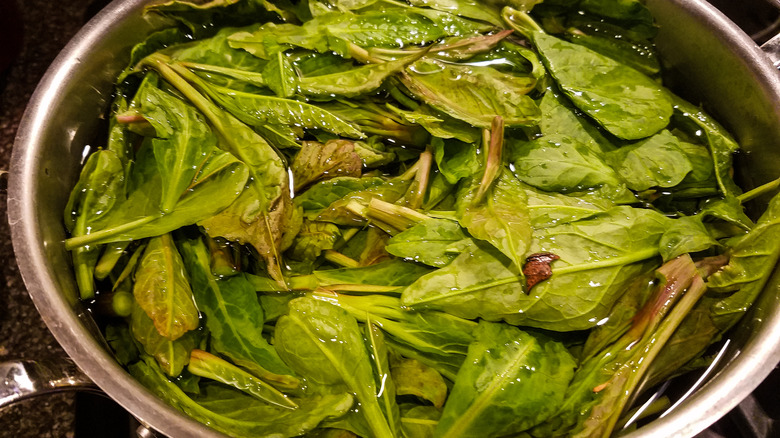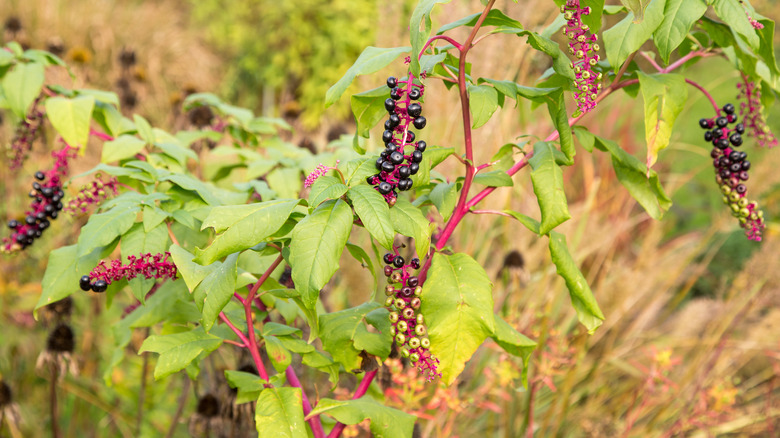Poke Salad Is An Appalachian Staple That Can Be Dangerous To Eat
Have you ever wished a boring iceberg salad was a little more exciting? High stakes? Dangerous, perhaps? Poke salad certainly can be, both because nearly every green is more exciting than iceberg lettuce and because if you prepare poke salad incorrectly, it's toxic.
Poke, or pokeweed, is a wild plant endemic to North America, particularly in the Appalachia region. It's a tall, non-woody perennial shrub that grows to be up to ten feet tall, with a thick stem, broad flat leaves, and dark purple berries. Young pokeweed can be foraged and eaten only if processed properly. The leaves, which can be used like spinach, must be boiled at least twice, changing out the water for freshness between boilings. If the plant is prepared incorrectly, it is toxic. Symptoms of pokeweed poisoning include seizures, diarrhea, unconsciousness, low blood pressure, rapid pulse, sweating, headaches, muscle spasms, and difficulty breathing. The root is considered the most toxic, while the ripe berries are considered the least toxic. But if you learn how to properly handle young poke leaves, they can be eaten as cooked greens.
Preparing poke salad
This, importantly, is not an instruction sheet for foraging, preparing, and eating poke salad. Any attempts to forage should always be done with an expert.
Pokeweed is typically harvested when the plants are young — generally under two feet tall — before there is any purple visible on the stems, leaves, or berries. The raw leaves get rinsed and boiled, then drained and squeezed, and then boiled again. This process is completed at least twice, but oftentimes people boil the leaves a third time. The poke leaves can then be sauteed like turnip greens, in lard or butter or bacon grease, and served like many other southern greens. They can be put into dishes other cooked greens go into, like quiche or a frittata. They're said to taste like turnip greens or spinach but with an aftertaste higher in minerality.
Though pokeweed isn't as much of a staple anymore, it certainly used to be — and with a resurgence in interest around foraging, it's coming back in certain niche circles. The Charlotte, North Carolina restaurant Heirloom, features wild-harvested poke on its menu every spring when it comes into season. Chef Clark Barlowe learned how to prepare poke from his maternal grandmother. The TikTok creator Alexis Nikole talks about the culinary history of poke salad, goes to bat for the plant, and repeatedly explains that poke is not a beginner-friendly forageable plant.
@alexisnikole LEAVE POKE ALONE 🤣 #LearnOnTikTok #TikTokPartner #pokeweed
Poke in culinary culture and more
In Appalachia, poke salad is often called poke sallet or sallit, and there's a whole festival thrown for it started by Larry Gholston in Georgia every Memorial Day weekend for the past 33 years. The festival features live music, food vendors, and — of course — poke salad tastings. Pokeweed used to be a staple in Appalachian communities, particularly for survival in Black communities. Gholston, a 70-year-old retiree, told the New York Times that his mom would wash it and cook it and that some relatives would serve it for Sunday dinner. Some older folks "back in the day" would make wine from the poke berries, and fry up the stalks like okra. But he also says that a lot of Black folks don't eat it anymore, because it has "connotations of poorness and rural." Since pokeweed is one of the first edible wild vegetables to pop up in the spring, it was foraged and eaten as the winter's stocks of preserved food were wearing thin. Gholston runs the festival each year to preserve the history and knowledge of foraging pokeweed.
Indigenous folks have used pokeweed for many applications throughout history, especially as medicine. Tribes in Delaware used it as a cardiac stimulant, tribes in Virginia boiled the berries for tea to treat rheumatism, and others used it to treat arthritis and dysentery. Powdered pokeweed root was even used as a cancer treatment. While it certainly has a storied history and questionable traits, poke is beloved by the many people who grew up eating it in their households.


